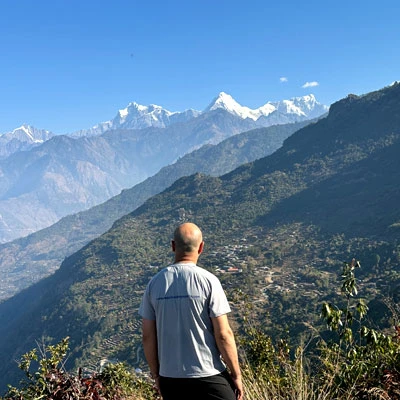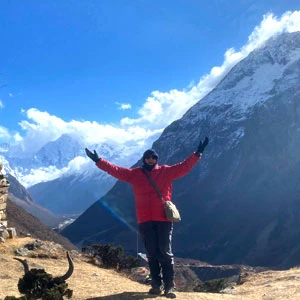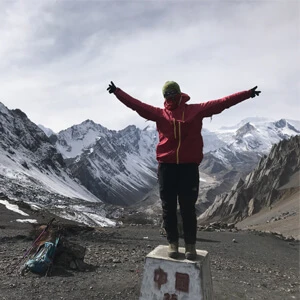Where Are Nar And Phu?
The Nar and Phu are the hidden treasures above 4,000 meters in the far northeastern pocket of Nepal’s Manang District. These ancient Himalayan villages lie off the beaten path, accessed by a rugged trail that branches north from the village of Koto, near Chame.
Because of their proximity to the Tibetan border and cultural sensitivity, Nar and Phu fall under a restricted trekking zone. Thus, you must obtain special permits and travel with a registered guide.
Talking about its geography, the terrain surrounding Nar and Phu is a patchwork of jagged rock faces, wind-swept passes, and views that stretch toward snow-draped peaks like Kangaru Himal and Himlung. The valleys are dry and barren in appearance. Here, both humans and wildlife have adapted to the valley’s harsh alpine climate.
People Of Nar And Phu
The people of Nar and Phu are the soul of these hidden valleys. Descended from Tibetan settlers, the communities are primarily made up of ethnic groups like the Lama, Ghale, and Gurung. With a combined population of just a few hundred, the villages feel more like extended families than separate households.
Generally, the local life here revolves around the seasons and the demands of the harsh alpine environment. You will find villagers rising early to tend to their terraced barley fields, herd yaks across the meadows, or spin wool into yarn for weaving thick garments.
They also engage themselves in trade, especially during the warmer months, when trails become passable and barter with nearby regions is possible. Likewise, the people of Nar Phu Valley communicate in a distinct dialect known as Nar-Phu, which is heavily influenced by classical Tibetan.
Culture And Religion Of Nar Phu Valley
The people of Nar Phu Valley follow Tibetan Buddhism. At every corner of the valley, you will witness various symbols of the religion, such as prayer flags fluttering in the wind, stoned mani walls carved with sacred mantras, spinning prayer wheels, and chortens that guard the entrance.
In this region, the locals follow a unique blend of the Kagyu and Nyingma schools of Tibetan Buddhism. Both of these emphasize meditation, compassion, and the guidance of enlightened masters.
During the trek, you will come across two sacred monasteries. In Phu, you will see the Tashi Lhakhang Monastery, which is believed to be over 700 years old. Its weathered walls have seen centuries of rituals, prayers, and monastic teachings, making it one of the most important religious sites in the region.
Just below Nar, you will get to explore the Nar Phedi Monastery, run by a small community of nuns. Here, you will also get a rare opportunity to stay overnight and witness the rhythms of Buddhist life firsthand.
Festivals And Traditions
If you are lucky enough to time your trek during the festival time, you will get to witness the Nar Phu Valley in its prime. Losar, the Tibetan New Year, is the most eagerly awaited celebration of the year.
It falls at the end of January, and you will find the locals don their finest handwoven garments for the celebration. They offer prayers and gather in courtyards for masked dances, fire rituals, and lavish feasts.
Now, in Summer, the valleys burst into life again during the Yartung Festival. At this event, locals organize horse races across the rugged terrain, accompanied by singing, dancing, and shared meals.
Beyond the festivals, seasonal migrations are an essential tradition. Villagers often move between high pastures and lower settlements, following age-old patterns to sustain their flocks and fields.
Lastly, monastic life is quite evident in their day-to-day life. Many families send their children, especially boys, to monasteries at a young age for religious education, discipline, and a life devoted to Buddhist teachings.
Architecture And Village Life
The homes in the Nar Phu Valley are built from stone, wood, and mud gathered directly from the land. They generally have flat roofs layered with hay.
Additionally, their homes are laid strategically to guard against both the piercing mountain winds and historical threats such as bandit raids or tribal conflicts. Likewise, they have narrow alleys between the houses with thick stone walls.
Moving on, locals here heavily rely on animal husbandry. Yaks, dzos (a cross between yaks and cows), and sheep are the major animals they have. These animals provide milk, wool, meat, transport, and even fuel in the form of dried dung.
Food And Cuisine
The cuisine of Nar and Phu is hearty and simple. In these remote Himalayan valleys, food is about energy, warmth, and nourishment.
Tsampa, a staple made from roasted barley flour, is the foundation of most meals. Locals mix it with hot tea or butter to form a dense, energy-rich dough that fuels long days of herding and farming.
Likewise, they have Thukpa, a warm noodle soup often packed with vegetables or yak meat. It is a comforting dish against the biting cold. Apart from these, you will, of course, find the traditional dal bhat, noodles, and occasionally momo.
And no meal in Nar or Phu feels complete without a cup of salty yak butter tea. It is rich, smoky, and surprisingly satisfying to drink.
Now, when you explore the traditional settlements, you will often see the locals hanging dried meat on their ceilings. Because the region does not get fresh produce every day, the locals have learnt to preserve their food in a unique way in the form of dried meat and fermented vegetables.
Folklore And Beliefs
As you explore the Nar Phu Valley, you will get numerous chances to hear the folklore and locals’ beliefs. Elders still pass down ancient myths of creation, heroic journeys, and the local deities who watch over the land.
Here, the locals deeply believe in “Dharma protectors.” They are the fierce guardian spirits tasked with shielding both the Buddhist faith and the community from harm. Likewise, the towering peaks are revered as sacred homes of mountain gods, who must be respected through prayer, offerings, and ritual.
Therefore, before any important events in their lives, people here pause to honor these unseen forces that shape their lives. Many legends talk about different stories on the formation of the Nar Phu Valley as well.
Modern Influence
The Nar and Phu valleys, once completely sealed off from the outside world, now welcome a small yet steady stream of trekkers. Indeed, tourism has brought new opportunities like homestays, guided treks, and a modest cash economy.
With the steady touch of modernity, some parts of the settlement do have electricity, solar panels, and basic mobile networks. The locals now charge phones using solar energy, and some homes even boast simple lighting systems.
Yet despite these changes, the essence of life here remains grounded. You will still find elders spinning prayer wheels, children helping herd yaks, and families gathered around butter lamps at dusk.
Hence, to maintain the authenticity of the valley as well as to help the locals with a modern touch, several NGOs have been working to preserve its cultural richness. They are focused on restoration projects for ancient monasteries, promotion of traditional weaving, and language conservation efforts.
Conclusion
Life in Nar and Phu is a rare glimpse into a world with ancient rhythms, whispered prayer, and a wind-swept valley. These villages, perched high in the Himalayas, offer a living heritage shaped by Tibetan roots, Buddhist devotion, and centuries of resilience.
If you are searching for more than just another mountain trek, Nar Phu Valley is the perfect choice. For this journey, you should trek with Nepal Trekking Experts as they ensure you experience the valleys through heartfelt stories, meaningful encounters, and deep cultural immersion.
FAQs
Where are Nar and Phu located?
Nar and Phu are remote villages in the Manang District, located northeast of the Annapurna Circuit in Nepal.
Do I need a guide to visit Nar and Phu?
Yes, hiring a licensed guide is mandatory due to the region’s restricted status.
What is the best time to visit Nar and Phu?
Spring (March to May) and Autumn (September to November) are the best times to visit Nar Phu Valley as they offer the best weather and views.
What kind of ethnic people live in Nar and Phu?
The villagers in Nar and Phu are mostly of Tibetan descent, including Lama, Ghale, and Gurung communities.
What language is spoken in Nar and Phu?
Locals speak a unique Nar-Phu dialect influenced by Tibetan.
What religion do the people in Nar Phu Valley follow?
The culture in this valley is deeply rooted in Tibetan Buddhism, especially the Nyingma and Kagyu traditions.
Are there any monasteries to visit in Nar Phu?
Yes. You can visit the Tashi Lhakhang in Phu and the Nar Phedi Monastery.
Is there electricity and a mobile network in the villages?
Yes. There is electricity and a mobile network in the area, but it is quite limited.
Can I visit the Na Phu Valley without a trekking agency?
No, you must book through a registered agency like Nepal Trekking Experts for permits and guides.
.webp)






